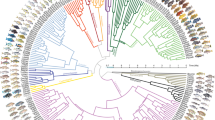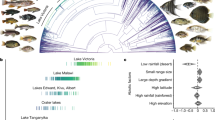Abstract
Explaining the ecological causes of evolutionary diversification is a major focus of biology, but surprisingly little has been said about the effects of evolutionary diversification on ecosystems1,2,3. The number of species in an ecosystem and their traits are key predictors of many ecosystem-level processes, such as rates of productivity, biomass sequestration and decomposition4,5. Here we demonstrate short-term ecosystem-level effects of adaptive radiation in the threespine stickleback (Gasterosteus aculeatus) over the past 10,000 years. These fish have undergone recent parallel diversification in several lakes in coastal British Columbia, resulting in the formation of two specialized species (benthic and limnetic) from a generalist ancestor6. Using a mesocosm experiment, we demonstrate that this diversification has strong effects on ecosystems, affecting prey community structure, total primary production, and the nature of dissolved organic materials that regulate the spectral properties of light transmission in the system. However, these ecosystem effects do not simply increase in their relative strength with increasing specialization and species richness; instead, they reflect the complex and indirect consequences of ecosystem engineering by sticklebacks. It is well known that ecological factors influence adaptive radiation7,8. We demonstrate that adaptive radiation, even over short timescales, can have profound effects on ecosystems.
This is a preview of subscription content, access via your institution
Access options
Subscribe to this journal
Receive 51 print issues and online access
$199.00 per year
only $3.90 per issue
Buy this article
- Purchase on Springer Link
- Instant access to full article PDF
Prices may be subject to local taxes which are calculated during checkout


Similar content being viewed by others
References
Thompson, J. N. Rapid evolution as an ecological process. Trends Ecol. Evol. 13, 329–332 (1998)
Fussmann, G. F., Loreau, M. & Abrams, P. A. Eco-evolutionary dynamics of communities and ecosystems. Funct. Ecol. 21, 465–477 (2007)
Yoshida, T., Jones, L. E., Ellner, S. P., Fussmann, G. F. & Hairston, N. G. Rapid evolution drives ecological dynamics in a predator–prey system. Nature 424, 303–306 (2003)
Schmitz, O. J. Predators have large effects on ecosystem properties by changing plant diversity not plant biomass. Ecology 87, 1432–1437 (2006)
Loreau, M. et al. Biodiversity and ecosystem functioning: current knowledge and future challenges. Science 294, 804–808 (2001)
McPhail, J. D. Ecology and evolution of sympatric sticklebacks (Gasterosteus): origin of the species pairs. Can. J. Zool. 71, 515–523 (1993)
Schluter, D. The Ecology of Adaptive Radiation (Oxford Univ. Press, 2000)
Seehausen, O. et al. Speciation through sensory drive in cichlid fish. Nature 455, 620–626 (2008)
Losos, J. B. Portrait of an Adaptive Radiation: Ecology and Evolution of Anolis Lizards (Univ. California Press, 2009)
Grant, P. R. & Grant, B. R. How and Why Species Multiply: The Radiation of Darwin’s Finches (Princeton Univ. Press, 2008)
Abrams, P. A. The evolution of predator–prey interactions: theory and evidence. Annu. Rev. Ecol. Syst. 31, 79–105 (2000)
Palkovacs, E. P. & Post, D. M. Experimental evidence that phenotypic divergence in predators drives community divergence in prey. Ecology 90, 300–305 (2009)
Snyder, W. E., Snyder, G. B., Finke, D. L. & Straub, C. S. Predator biodiversity strengthens herbivore suppression. Ecol. Lett. 9, 789–796 (2006)
Lennon, J. T. & Martiny, J. B. H. Rapid evolution buffers ecosystem impacts of viruses in a microbial food web. Ecol. Lett. 11, 1178–1188 (2008)
Erwin, D. H. Macroevolution of ecosystem engineering, niche construction and diversity. Trends Ecol. Evol. 23, 304–310 (2008)
Colosimo, P. F. et al. Widespread parallel evolution in sticklebacks by repeated fixation of ectodysplasin alleles. Science 307, 1928–1933 (2005)
Rundle, H. D., Nagel, L., Boughman, J. W. & Schluter, D. Natural selection and parallel speciation in sympatric sticklebacks. Science 287, 306–308 (2000)
Boughman, J. W. Divergent sexual selection enhances reproductive isolation in sticklebacks. Nature 411, 944–947 (2001)
Bell, T., Neill, W. E. & Schluter, D. The effect of temporal scale on the outcome of trophic cascade experiments. Oecologia 134, 578–586 (2003)
Schmitz, O. J. Effects of predator hunting mode on grassland ecosystem function. Science 319, 952–954 (2008)
Goudard, A. & Loreau, M. Non-trophic interactions, biodiversity and ecosystem functioning: an interaction web model. Am. Nat. 171, 91–106 (2008)
Stibor, H. et al. Copepods act as a switch between alternative trophic cascades in marine pelagic food webs. Ecol. Lett. 7, 321–328 (2004)
Jones, C. G., Lawton, J. H. & Shachak, M. Positive and negative effects of organisms as physical ecosystem engineers. Ecology 78, 1946–1957 (1997)
Mazumder, A., Taylor, W. D., McQueen, D. J. & Lean, D. R. S. Effects of fish and plankton on lake temperature and mixing depth. Science 247, 312–315 (1990)
Williamson, C. E., Morris, D. P., Pace, M. L. & Olson, A. G. Dissolved organic carbon and nutrients as regulators of lake ecosystems: Resurrection of a more integrated paradigm. Limnol. Oceanogr. 44, 795–803 (1999)
Retamal, L., Vincent, W. F., Martineau, C. & Osburn, C. L. Comparison of the optical properties of dissolved organic matter in two river-influenced coastal regions of the Canadian arctic. Estuar. Coast. Shelf Sci. 72, 261–272 (2007)
Ghan, D., McPhail, J. D. & Hyatt, K. D. The temporal-spatial pattern of vertical migration by the freshwater copepod Skistodiaptomus oregonensis relative to predation risk. Can. J. Fish. Aquat. Sci. 55, 1350–1363 (1998)
Obernosterer, I. & Benner, R. Competition between biological and photochemical processes in the mineralization of dissolved organic carbon. Limnol. Oceanogr. 49, 117–124 (2004)
McKnight, D. M. et al. Spectrofluorometric characterization of dissolved organic matter for indication of precursor organic material and aromaticity. Limnol. Oceanogr. 46, 38–48 (2001)
Pienitz, R. & Vincent, W. F. Effect of climate change relative to ozone depletion on UV exposure in subarctic lakes. Nature 404, 484–487 (2000)
Acknowledgements
We thank A. Albert, T. Vines, D. Yim, P. Tamkee, J. Courchesne, R. Barrett, K. Marchinko, M. Arnegard, J. Sashaw, J. Gosling, S. Hausch, J. Rosenfeld and S. Rogers for assistance in the laboratory and the field. We thank E. B. Rosenblum and members of the Harmon laboratory for comments on the manuscript.
Author information
Authors and Affiliations
Corresponding author
Supplementary information
Supplementary Information
This file contains Supplementary Notes and Data, Supplementary Figure S1 with Legend and Supplementary References (PDF 528 kb)
PowerPoint slides
Rights and permissions
About this article
Cite this article
Harmon, L., Matthews, B., Des Roches, S. et al. Evolutionary diversification in stickleback affects ecosystem functioning. Nature 458, 1167–1170 (2009). https://doi.org/10.1038/nature07974
Received:
Accepted:
Published:
Issue Date:
DOI: https://doi.org/10.1038/nature07974
This article is cited by
-
Horizontal gene transfer is predicted to overcome the diversity limit of competing microbial species
Nature Communications (2024)
-
Eco-evolutionary feedbacks in the human gut microbiome
Nature Communications (2023)
-
Individual variability in foraging success of a marine predator informs predator management
Scientific Reports (2022)
-
Stickleback mass occurrence driven by spatially uneven parasite pressure? Insights into infection dynamics, host mortality, and epizootic variability
Parasitology Research (2022)
-
Uncovering how behavioral variation underlying mutualist partner quality is partitioned within a species complex of keystone seed-dispersing ants
Insectes Sociaux (2022)
Comments
By submitting a comment you agree to abide by our Terms and Community Guidelines. If you find something abusive or that does not comply with our terms or guidelines please flag it as inappropriate.



